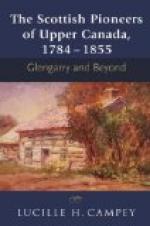[Footnote 13: The name Nova Scotia was not applied to this peninsula until 1621, by the British Government. It was at first included with New Brunswick under the Spanish name of Norumbega, and after 1603 was called by the French “Acadie".]
From Cape North he crossed over to the south coast of Newfoundland, and followed this more or less till he came to Cape Race. Newfoundland was a “very cold and savage land”, and Gomez decided it was no use prosecuting any farther his enquiry as to a water passage across North America, because, if it existed, it must lie in latitudes of frozen sea and be unnavigable.
At different places along the east coast of North America he kidnapped natives, and eventually returned to Spain (via Florida and Cuba) with a cargo of Amerindian slaves.
He had been preceded, by seven or eight months, in his explorations along the same coast by GIOVANNI DA VERRAZANO, a native of Florence, who as a navigator and explorer had visited the East, and had associated himself a good deal with the shipowners of Dieppe. Ever since the issue of Cabot’s voyages was known—at any rate from 1504—ships from Brittany and Normandy had made their way to Cape Breton Island and Newfoundland for the cod fisheries. In 1508 a Norman named Aubert was sent out by Jean Ango—a great merchant of Dieppe of that day—to found a colony in Newfoundland. Aubert failed to do this, but he captured and brought away at least seven of the natives, no doubt of the Beothik tribe, from Newfoundland to Rouen, with their canoe, clothing, and weapons. A good many ships also went out from La Rochelle on the west coast of France, and took part in the fishing off the coast of Newfoundland: together with the ships of Brittany and Dieppe there may have been a French fishing fleet of seventy to eighty ships plying every summer season between France, Newfoundland, and Cape Breton. So that when “John from Verrazano” offered his services to Francis I to make discoveries across the ocean, which should become possessions of the French Crown, he was quickly provided with the requisite funds and ships.
Verrazano started on the 17th of January, 1524, for the coast of North America, but I shall say little about his expedition here, because it resulted chiefly in the discovery and mapping of what is now the east coast of the United States. He reached as far as the south coast of Newfoundland, it is true; he also gave the names of Nova Gallia and Francesca to the coast regions of eastern North America, and distinctly intended to take possession of these on behalf of the French Crown. But his work in this direction did not lead directly to the creation of the French colony of Canada, because, when he returned from America, Francis I was at war with Spain, and could pay no attention to Verrazano’s projects. His voyage is worth recording in the present volume only for these two reasons: he certainly put it into the minds of French people that they might found an empire




